It’s a brilliant idea to plant palm trees for landscapes on the remaining land behind or in front of the house. Because this area can be an area with artistic flavors in your home.
You can use it as a place to relax with your family, a play area for children, or just a garden to decorate your home. Then, how much do you understand about palm tree landscaping?
For that, we are here to discuss it. Keep reading until the end, we will provide a lot of information for you regarding that.
What is Landscapes Anyway?
The definition of Landscapes often refers to an area that has an arrangement of visual representations. In real terms in the physical context, the term landscapes describe a (visual) interpretation of an area or land composition. This is the only way to represent a visual in a feeling.
Why Are Palm Trees Suitable for Landscapes?
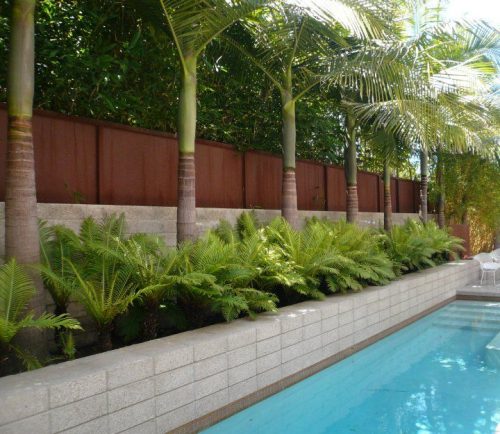
Palm trees make a great choice for landscape plants. The main reason is that palms have shallow roots about 90 cm deep, so they do not invade.
This means that you can freely plant this tree near swimming pools and other buildings. Even so, experts still recommend that you keep a distance when planting this tree, at least 1.8-3.0 meters from swimming pools or buildings.
How to Create Palm Tree Landscapes Designs
Palm trees can be a landscaping element in your front or back garden to make them look more beautiful. So, if you don’t know how you can do it, read this short tutorial for more details.
- Select the type or species of palm you want to plant. Palm plants have many types, this is related to their size and the ability to adapt to the weather in your environment. It all depends on the type of palm itself.
- Budget, Beauty, and Location. You can choose to plant palms starting from small buds or full-grown palms that are large. The price of large size palms is certainly more expensive than buds. To be honest, the beauty of a full-grown plant is worth the price, but if the area you have is not very large, it is better to plant a buds palm or one that is still growing.
- Front yard or backyard. Your choice of landscapes location determines the size of the palm tree you plant and vice versa. When it comes to growing mature palm trees, your front garden commonly may be easier to reach than a backyard garden. Because maybe you need the help of heavy equipment to help the planting process.
Best Palm Trees Species for Landscapes
Areca Palm (Dypsis lutescens )
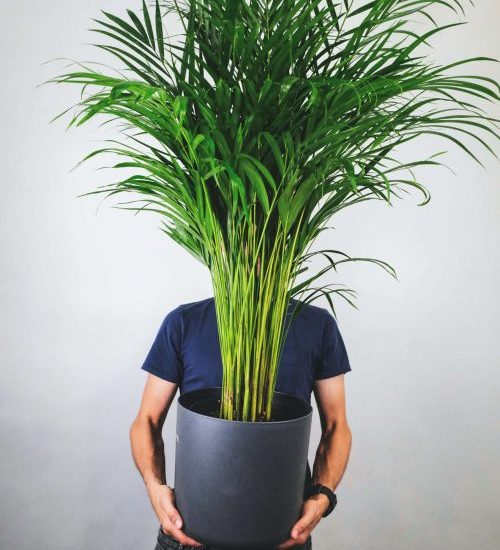
- This palm tree species are also known as Golden cane palm, bamboo palm, yellow palm, or butterfly palm.
- Has green leaves or fronds with yellow, gold, or even silver leaflets and stems.
- The fronds have 4 to 6 feet long with a bare petiole.
- Arecas has gold look from a distance.
- At the base of the leaf stems typically has dark spots or specks.
- The cross-section of leaves forms a “V shape”.
- Has 25 to 30 feet of total height.
- Origin from Madagascar and tropical India, the Solomon Islands, Philippines, Malaysia, Southern China, and Australia.
These palm trees usually use for shrub or hedges in landscapes area.. It is drought tolerant, for that reason it widely planted throughout sub-tropical and tropical climates.
Canary Island Date Palm (Phoenix canariensis)
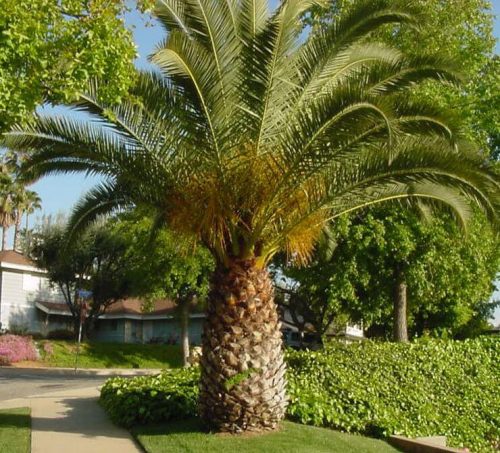
- This palm tree species is also popular as a pineapple palm.
- A beautiful palm tree that has a wide trunk lined with diamond patterns (look as pineapple).
- Has arching fronds as a dense crown.
- Belong a very slow grower, takes decades just to reach 60 feet of height.
- Origin from the Canary Islands, In New Zealand.
These Canary Island palm trees are often used for luxury residential and commercial property. Its luxurious appearance and easy maintenance make it highly desirable among gardeners and tree nurseries.
Chinese Fan Palm (Livistona chinensis)

- This palm tree species is also known as the Chinese fountain palm.
- Has large, fan-shaped leaves with bright green.
- The leaves, or fronds, have about 5 feet in diameter and droop downward, form a fountain-like shape on a single trunk.
- Has 15 to 25 feet of total heights, despite in its native habitat it can grow to 50 feet.
- Has a wider base trunk with brown to a grayish color.
- Origin from Taiwan, Southern Japan, and several islands in the South China Sea.
The Chinese fan palm tree is quite a drought-tolerant, so it is suitable for use as a landscape element in drought-stricken areas. For example in the California area.
Good irrigation will ensure faster growth of these palms. The smaller tree looks attractive, perfecting an effective privacy screen for a tiny tropical bed.
Mediterranean Fan Palm (Chamaerops humilis)
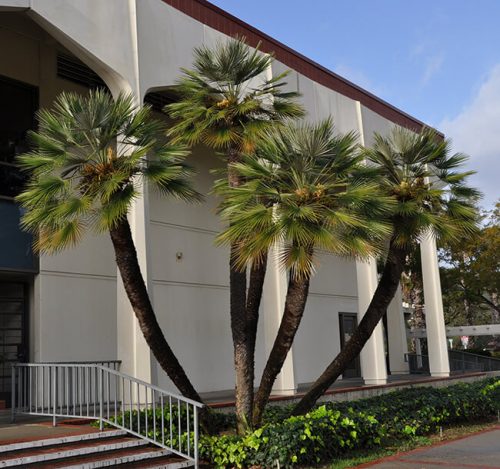
- This Mediterranean Fan Palm is also known as the European fan palm.
- This palm species grown in clumps, each clump usually have up to five separate stems or trunks.
- The trunk has a rough texture since itis covered by leaf scars.
- It has triangular-shaped fronds that grow upright with about 2 feet wide.
- The leaf’s colors are gray-green to blue-green.
- This can grows slowly to about 20 feet in height.
- Derived from the Mediterranean region, these can be found in southwestern Europe and Africa.
This palm tree species produces many tough stems or trunks, suitable for open front yard landscapes. This plant can withstand cold weather up to 0 ° such as in Zones 4 to 24.
Queen Palm (Syagrus romanzoffiana)
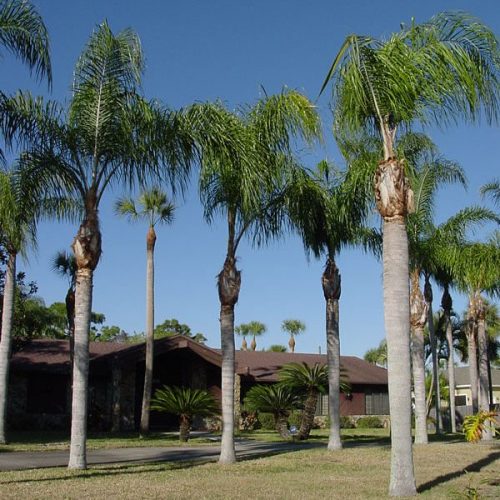
- This palm tree species has another name of Cocos plumosa.
- A queen palm has a straight trunk with a smooth surface.
- Has graceful, glossy, plume-like fronds.
- It can grow up to 50 feet in height or more.
- It produces orange-red fruits that can get messy while drop.
- Origin from Brazil and South America.
These beautiful palms provide a nice vertical effect for landscapes in larger residential properties. Just remember not to plant them near a path, terrace, or pool due to their messy fruit droppings.
Windmill Palm (Trachycarpus fortunei)
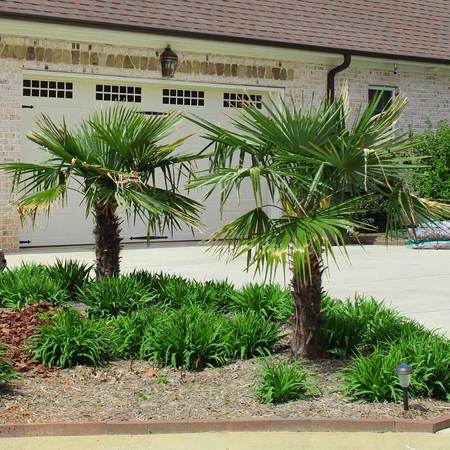
- This palm tree species are also known as Chusan palm and Chinese windmill palm.
- Windmills palm have slim trunks with hairy black Fronds about 4 feet in diameter.
- The leaves or it pinnate fronds grow in an upward direction with a dark green color upside and a silver-green on its underside.
- This also belongs as a slow grower, even so, it can reach 20 to 40 feet in height.
- Origin from central and eastern China.
Windmills palm trees are ideal for the landscape element, it can use as a patio tree either indoors or outdoor. So, these plants are very popular palm with home gardeners.
Further, this is unlike other palms, it can be grown in states like Alaska, Mississippi, Massachusetts, and New York (USDA zones 7 to11).
Palm Trees Landscapes Tips
Climate Conditions for Palm Trees Landscapes
Before planning a palm trees landscapes, understand your climatic conditions first. This determines which palm species are suitable for the temperature in which you live.
You can of course still get a lush, green landscape view with palm trees, even though you don’t live in a tropical climate. Because there are several varieties of palm trees that can survive cold temperatures even down to zero degrees F!
Size and Species of Palm Trees for Landscapes
Apart from considering the look you want, climate tolerance is the most important factor in choosing the right species. There are thousands of species of palm trees in the world, so which one is suitable for your area?
The easiest way is to choose the type of tree that is grown locally in your area. To find the best size for your yard, consult with reputable nursery experts in your area.
Ideal Place to Plant Palms
Availability of light is the most important thing to consider when choosing an area for palm tree landscaping. Apart from that you also have to pay attention to how your palm tree grows. Will it have large leaves to add shade to your backyard? Or will it even drop the messy fruit?
How to Use Fertilizers

Most experts say you don’t need to fertilize your palm tree when you put it in the ground. It will shock them again once you move the palm tree from the pot to the ground. Ideally, you should wait six to eight weeks after planting for the first fertilization. And, if you want to fertilize afterward, it’s best to use a slow, safe fertilizer.
Continuous Care for Your Palms Trees
If you live in a very hot climate, then you should water your palm tree frequently. Conversely, if you live in a cooler climate, it doesn’t need much water. Water every one or two days for the first two weeks after planting. This aims to maintain sufficient soil moisture around the roots.
You can also do some pruning to be able to identify if any potential problems with your palm tree early on and fix them.
Tropical Plants to Pair With Palm Trees
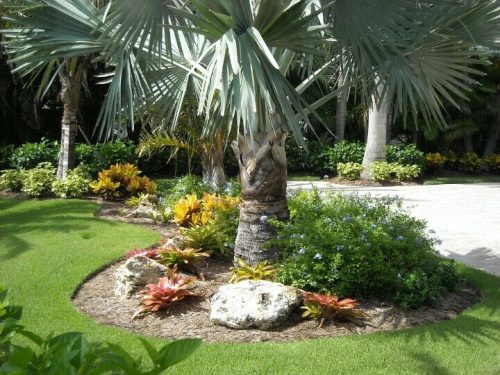
To embellish your palm trees landscapes, try pairing tropical plants with palm trees. This will make for an interesting grouping. In simple terms, you can mix smaller plants between large varieties.
For example, thin-leafed Needle Palm can be paired with plants that have broad leaves, such as a bird of paradise. Then for lower plants, you can use feathery ferns or philodendrons, to add texture.